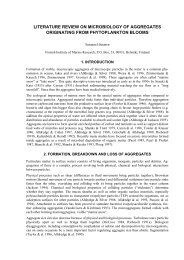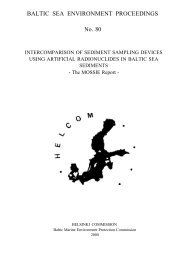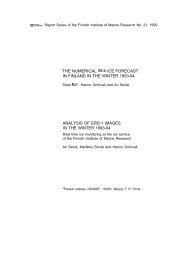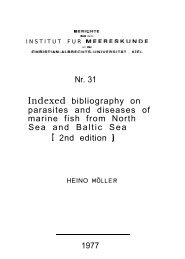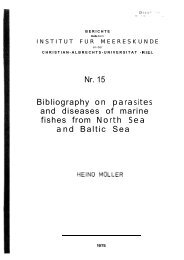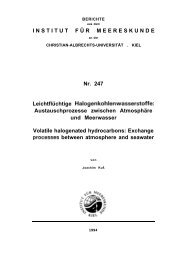marine research in finland - Baltic Marine Environment Bibliography
marine research in finland - Baltic Marine Environment Bibliography
marine research in finland - Baltic Marine Environment Bibliography
Create successful ePaper yourself
Turn your PDF publications into a flip-book with our unique Google optimized e-Paper software.
However, studies on the pelagic primary production and its connection to the hydrodynamics<br />
and nutrient level <strong>in</strong> F<strong>in</strong>nish coastal waters did not beg<strong>in</strong> until the sixties. After the microbial<br />
loop had been demonstrated <strong>in</strong> ocean ecosystems <strong>in</strong> the early seventies, modem <strong>research</strong> on the<br />
<strong>mar<strong>in</strong>e</strong> pelagic ecosystem commenced at Tvarm<strong>in</strong>ne Zoological Station and at the F<strong>in</strong>nish Institute<br />
of Mar<strong>in</strong>e Research. Good <strong>research</strong> on the structure and processes of the <strong>mar<strong>in</strong>e</strong> pelagic<br />
ecosystem has been made at those <strong>in</strong>stitutions. Dur<strong>in</strong>g recent years much resources have been<br />
directed towards <strong>research</strong> <strong>in</strong>to bacterial production, the microbial loop, autotrophic picoplankton.<br />
the dynamics of blue-green algae and the <strong>in</strong>fluence of climate change on the <strong>mar<strong>in</strong>e</strong> ecosystem<br />
(the SILMU-project).<br />
Great support has been offered to the nitrogen project, the aim of which is to study the nitrogen<br />
cycle <strong>in</strong> F<strong>in</strong>nish coastal waters and to give an answer to the difficult question “Is it profitable to<br />
remove nitrogen from waste effluent”.<br />
Look<strong>in</strong>g from the standpo<strong>in</strong>t of the Research Council of Natural Sciences, <strong>in</strong>temationally-acknowledged<br />
basic <strong>research</strong> on the <strong>Baltic</strong> brackish-water ecosystem is performed at the F<strong>in</strong>nish<br />
Institute of Mar<strong>in</strong>e Research, Hels<strong>in</strong>ki and at the Tvarm<strong>in</strong>ne ZoologicalOStation of the University<br />
of Hels<strong>in</strong>ki. The littoral project group at Husii Biological Station (Abo Academy) has also<br />
ga<strong>in</strong>ed <strong>in</strong>ternational acknowledgement. All qualified <strong>research</strong> groups have developed close <strong>in</strong>ternational<br />
cooperation. For <strong>in</strong>stance, the F<strong>in</strong>nish Institute of Mar<strong>in</strong>e Research, Hels<strong>in</strong>ki, the National<br />
Board of Waters and <strong>Environment</strong>, F<strong>in</strong>land and the Tv3m<strong>in</strong>ne Zoological Station all take<br />
part <strong>in</strong> the <strong>in</strong>ternational Gulf of Riga Project.<br />
Research on polar <strong>mar<strong>in</strong>e</strong> ecosystems is <strong>in</strong>cluded <strong>in</strong> the programme of the F<strong>in</strong>nish Institute of<br />
Mar<strong>in</strong>e Research. In accordance with the Antarctic Convention, F<strong>in</strong>land is obliged to regularly<br />
perform scientific <strong>research</strong> <strong>in</strong> the southern polar area, although it is very expensive and resources<br />
to support participat<strong>in</strong>g scientists have been difficult to arrange. RV Aranda is also very<br />
expensive. The Institute has also taken part <strong>in</strong> <strong>mar<strong>in</strong>e</strong> biological <strong>research</strong> <strong>in</strong> the Barents Sea<br />
area. F<strong>in</strong>nish participation <strong>in</strong> <strong>in</strong>ternational polar <strong>mar<strong>in</strong>e</strong> projects presupposes that F<strong>in</strong>land has a<br />
<strong>research</strong> vessel of top quality, and that the scientists have enough know-how to take part <strong>in</strong> <strong>in</strong>ternational<br />
<strong>research</strong> projects as equal members.<br />
In this presentation many monitor<strong>in</strong>g studies <strong>in</strong> coastal waters by local governmental organizations<br />
are not <strong>in</strong>cluded, despite their importance. However, the bilateral project between Sweden<br />
and F<strong>in</strong>land, the “Gulf of Bothnia Year” as well as the “Eastern Gulf of F<strong>in</strong>land Project” conducted<br />
by the National Board of Waters and <strong>Environment</strong>, have to be mentioned. Not only do<br />
they produce important <strong>in</strong>formation for coastal water protection plann<strong>in</strong>g and measures, but also<br />
good basic <strong>research</strong> which should be published <strong>in</strong> <strong>in</strong>ternational journals. It is a pity that much<br />
important <strong>in</strong>formation is hidden <strong>in</strong> dusty reports and will not be analyzed and used.<br />
The oldest and most diversified monitor<strong>in</strong>g (also biological) of eutrophicated coastal waters has<br />
been performed <strong>in</strong> the area off the coasts of Hels<strong>in</strong>ki and Espoo s<strong>in</strong>ce the sixties by the Water<br />
Laboratory of the City of Hels<strong>in</strong>ki. The new automatic monitor<strong>in</strong>g equipment on board <strong>Baltic</strong><br />
passenger boats, organized by the F<strong>in</strong>nish Institute of Mar<strong>in</strong>e Research and by Estonian scientists,<br />
collects rout<strong>in</strong>e <strong>in</strong>formation on the state of the sea area <strong>in</strong> the Gulf of F<strong>in</strong>land and the <strong>Baltic</strong><br />
Sea proper.<br />
Intellectual and material resources<br />
It is simply a question of scientific competence and money. Unfortunately these matters are connected.<br />
The present time <strong>in</strong> F<strong>in</strong>land is characterized by great changes. The material resources of<br />
the universities are be<strong>in</strong>g cut down at the same time as more. and better results are demanded.<br />
We have to reorganize our work and to make it more effective. In this connection one can compare<br />
some aspects of the universities and the governmental <strong>research</strong> <strong>in</strong>stitutes and their cooperation<br />
which is often called for <strong>in</strong> speeches of officers of the M<strong>in</strong>istry of Education - as if there<br />
had not been any cooperation earlier.<br />
41




